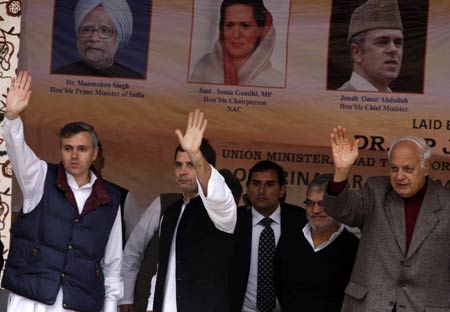The newly rediscovered Comaraderie between Omar Abdullah and Rahul Gandhi, the scions of Abdullah and Gandhi dynasties, has raised quite some eyebrows. While many people are optimistic that it will be good for a state ravaged by conflict, history has some lessons to offer, TASAVUR MUSHTAQ reports.

The age old relationship between Abdullah and Gandhi families was reinvigorated in the picturesque Sonamarg when Surface and Road Transport minister, C P Joshi, laid the foundation stone of twin-lane 6.5 km, Rs 2716 crore Z-Morh tunnel on Srinagar-Leh National Highway between Gagangir and Sonamarg. The road, primarily a pressing requirement for defence, would require another twin lane 13 km tunnel near Baltal to bypass the perilous Zoji La pass. It is expected to cost another Rs 5500 crore. Once the two tunnels are ready, Ladakh’s six-months-a-year isolation from rest of the world will end.
On the inaugural occasion, the young scions of Abdullah and Gandhi dynsaties, Omar Abdullah and Rahul Gandhi, were seen together in almost similar dresses and the body language negated the contents of reportage that there was a gulf between them. Invoking the memories of life long relationship between Jawaharlal Nehru and Sheikh Mohammad Abdullah, Rahul said he was extending the same support to Omar Abdullah for the holistic and comprehensive development of the state.
“I myself am from (a) Kashmiri family and want to have lifelong relations with the people of J&K,” Rahul Gandhi said in his brief speech. “I want to strengthen these relations,” he said.
Emphasizing that youth should come forward and get involved in developmental process, Rahul said, “I want to hear you, understand your problems and work for their redressal. I visited J&K last year. I came here again this year and would come again and again to meet the people. I want to share the difficulties of people.”
Referred to as the ‘heir apparent’, Rahul said all the states in India have undergone significant development in all fields of life. “Every state enjoyed share in the development process and J&K deserves all round development and economic welfare.” This is perhaps the first time that Rahul Gandhi visited the state with a business motive as he is likely to address corporate concerns regarding investment in Kashmir.
Business tycoons such as Chairmen of the Tata group, Aditya Birla group in addition to Deepak Parikh (HDFC chairman), Rajeev Bajaj (MD of Bajaj auto) as well as Aziz Premji (Managing Director of WIPRO) were also invited by Rahul Gandhi to accompany him to Kashmir.
On his first visit to university in September last year , 42-year-old Rahul tried to struck an emotional chord with the students when he had said that he was “a Kashmiri” and “the pain and the suffering of this place is my suffering as well.”
Besides a handful of NSUI members, the visit of Rahul to university campus is strongly opposed by the student community who allege that this was the ‘politicization’ of academic institution and blame the government for adopting different yard sticks.
“When Syed Ali Geelani is barred to enter the campus, how can government facilitate visit of Rahul,” Mohsina, a management student told Kashmir Life.
The visit of Rahul to Jammu and Kashmir is not an isolated event: it is believed to be pact of the larger game plan of Congress party to strengthen the already existing base of Congress in state. Rahul kick-started his two- day visit to Jammu & Kashmir when he landed in Leh where he had detailed interactions with the Ladakh Autonomous Hill Development (LAHDC) officials and complimented the Panchayat system of Leh, saying this model should be practised in the entire country. Leh district has nine blocks with over 600 panchayat members.
“The model of Panchayati Raj followed here is far more effective than the one practised in Uttar Pradesh. This model is going to set an example for the entire nation,” said the young leader of Congress. He told a gathering in Leh’s Polo Grounds that Congress would do everything possible to reduce the problems of the people especially in remote belts like Ladakh.















